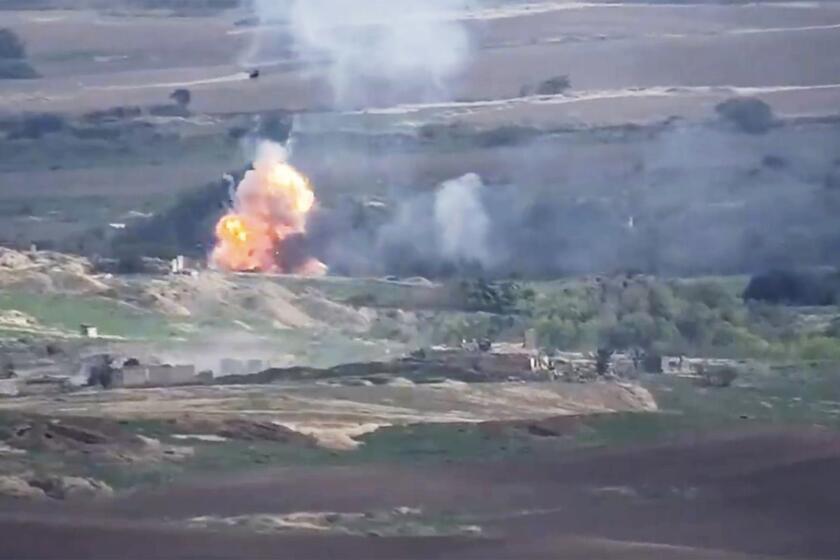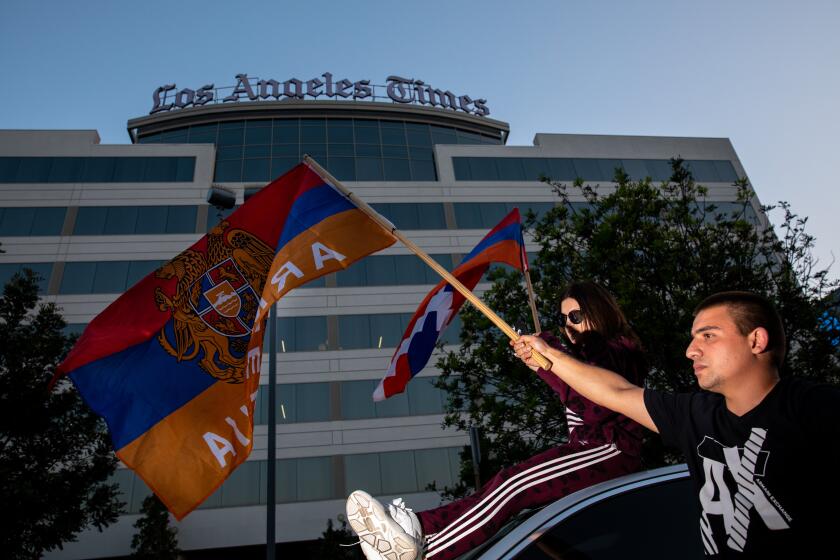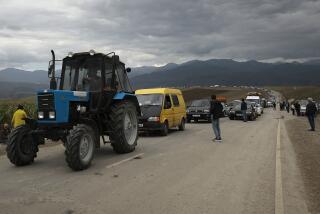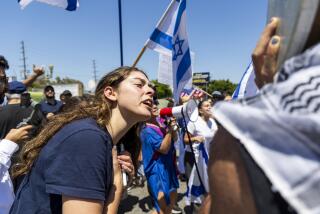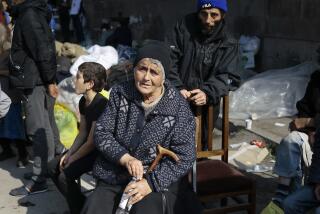Here’s why Armenian Americans in Southern California are protesting
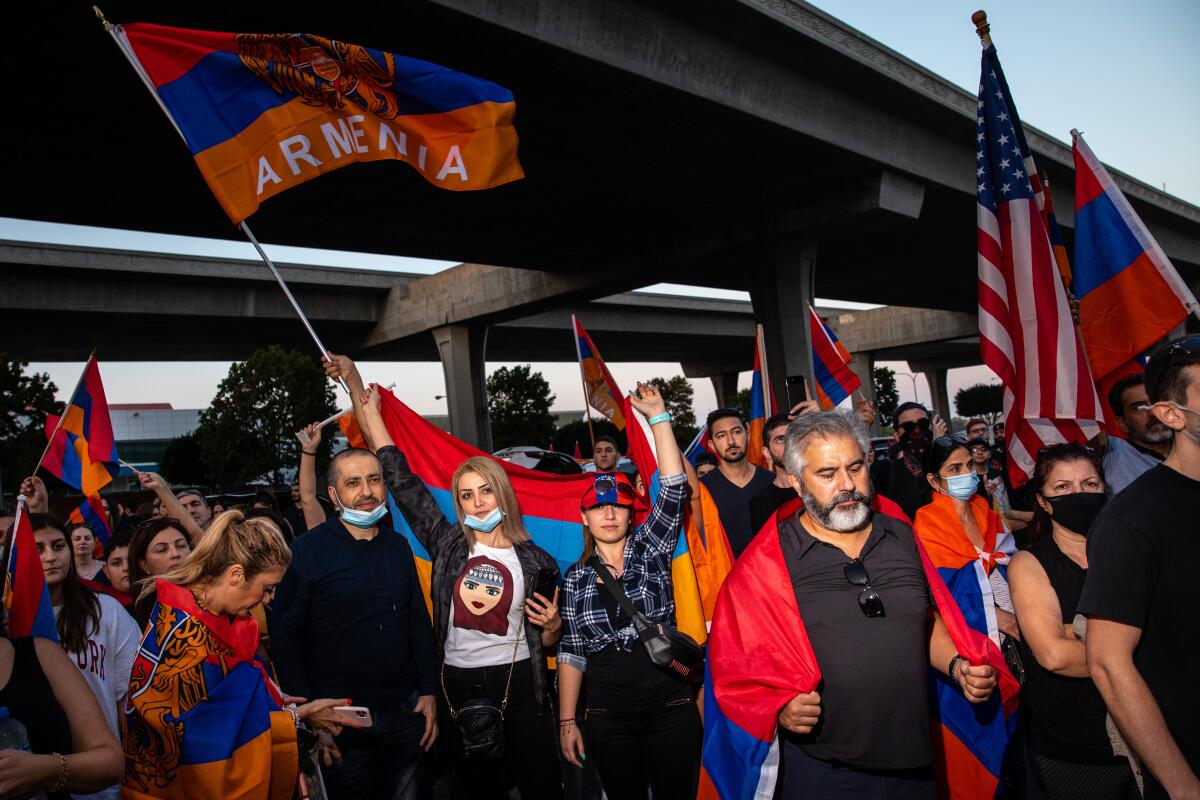
- Share via
Since Sept. 27, the escalating conflict in Nagorno-Karabakh has killed hundreds and displaced thousands, and Armenian Americans in Southern California have taken to the streets in protest.
In the days and weeks before a cease-fire was announced late Friday, thousands gathered outside the Azerbaijan Consulate in Los Angeles, blocked traffic on the 101 and 170 freeways, marched in Glendale and assembled in front of the buildings of CNN and the Los Angeles Times. On Wednesday, a crowd shut down Wilshire Boulevard in Westwood, and on Thursday, many traveled to Washington to protest in front of the White House.
On Sunday, tens of thousands protested outside the Turkish Consulate in Beverly Hills.
In addition to the protest, the Armenian American community has launched fundraisers and social media campaigns (shared by the likes of the Kardashians), and some have left or are preparing to leave Southern California with plans to volunteer and fight.
All in the midst of a pandemic and a chaotic U.S. election.
Southern California is home of one of the largest Armenian diasporas. The first significant wave of immigrants arrived after escaping the Armenian genocide of 1915. (The Turkish government disputes that the deaths — estimates range from 600,000 to 1.5 million people killed under the Ottoman Empire — constituted a genocide.)
In 2000, an East Hollywood neighborhood was designated Little Armenia. Glendale is home to the biggest Armenian American community in the region, in addition to significant populations in Burbank, Pasadena, Montebello and La Crescenta.
Here’s the background on how the conflict got to this point and its implications in Southern California.
What is the history of the conflict?
The tiny mountainous South Caucasus enclave Nagorno-Karabakh, referred to by Armenians by its historical name, Artsakh, is recognized internationally as part of Azerbaijan, but its population of 150,000 is mostly ethnic Armenian.
It is self-ruling and receives funding from Armenia and the Armenian diaspora, which is far larger than Armenia’s population of about 3 million.

“Caucasus has always been in the middle of three empires,” said Salpi Ghazarian, director of the USC Institute of Armenian Studies. “It used to be the Russian, Ottoman and Persian empires, now it’s Russia, Turkey and Iran. In that Caucasus area, lots of ethnic groups have always lived together, on top of each other. The borders were always shifting … because everyone was always gerrymandering.”
The conflict over Nagorno-Karabakh can be traced to the beginnings of the Soviet Union. In 1923, Nagorno-Karabakh became part of Soviet Azerbaijan while maintaining its autonomous status.
Around the 1991 collapse of the Soviet Union, there were attempts from Nagorno-Karabakh to break away from Azerbaijan, which were met with violence. About 30,000 people were killed and 1 million displaced. Armenia and Azerbaijan have had a cease-fire since 1994.
Violence has flared periodically since that cease-fire, notably during 2016’s Four-Day War, when clashes left hundreds dead.
As Armenia-Azerbaijan fighting intensifies over separatist region, wider rivalries could come into play
What is the recent history?
In July, border clashes resulted in deaths of both Armenian and Azebaijani servicemen.
Problems started much earlier, said Philip Gamaghelyan, an assistant professor at the Joan B. Kroc School of Peace Studies at the University of San Diego. He is also the co-founder of the Imagine Center for Conflict Transformation and the managing editor of the Caucasus Edition: Journal of Conflict Transformation.
“Negotiations were very active until about 2011, when they essentially stopped working on a solution,” he said.
In 1992, the Organization for Security and Cooperation in Europe formed the Minsk Group, with Russia, France and the U.S. in charge of finding a diplomatic solution in Nagorno-Karabakh.
“They were not successful for many reasons,” Ghazarian said, “but it also wasn’t on anybody’s top agenda.”
While the Clinton and Bush administrations were very involved, the U.S. started pulling out of the region during the Obama administration, and that continued during Trump’s presidency, Gamaghelyan said.
“The absence of meaningful negotiations made eventual war more and more likely,” he said. “And it made space for other local actors such as Turkey to start making moves.”
Before, other countries were supporting one side or another but not getting directly involved, Gamaghelyan said. Armenia said last month that a Turkish warplane had shot down an Armenian jet. But Turkey and Azerbaijan vigorously denied that.
Turkey is vocally supporting Azerbaijan. President Recep Tayyip Erdogan said recently that a call for peace from France, Russia and the U.S. was unacceptable and “our Azerbaijani brothers are now waiting for the day they will return to their land.”
Turkish involvement is terrifying for the Armenian American community, many of whom have familial ties to the genocide.
Laurence Broers, a scholar on the conflict, told The Times that although Azerbaijan instigated this attack, that country sees the conflict as a defensive war to reclaim lost land.
The cease-fire is expected to begin Saturday at noon.
The protesters shut down Imperial Highway and Douglas Street about 6 p.m. Tuesday, with some chanting, “Shame on the L.A. Times.”
How does the conflict play out in Southern California?
Talar Chahinian, a lecturer in the Armenian Studies Program at UC Irvine, said many Armenians in California got the news that Stepanakert, the capital of Nagorno-Karabakh, was being attacked around midnight Sept. 27 or woke up to it the next morning.
“There was a sense that this was the big one,” she said. “Just like in California, when you’re always anticipating the Big One, the big earthquake. Everybody the next day, on every thread, every space I was checking into, from academic to personal, it was this fear that they’re coming to get us. They’re going to finish what they started, the genocide. It was a very personal reaction that people were having.
“It felt like this is the last line,” she continued. “We knew civilians were being attacked, the capital was attacked, Turkey was open that they were in on it, and it felt very different this time.”
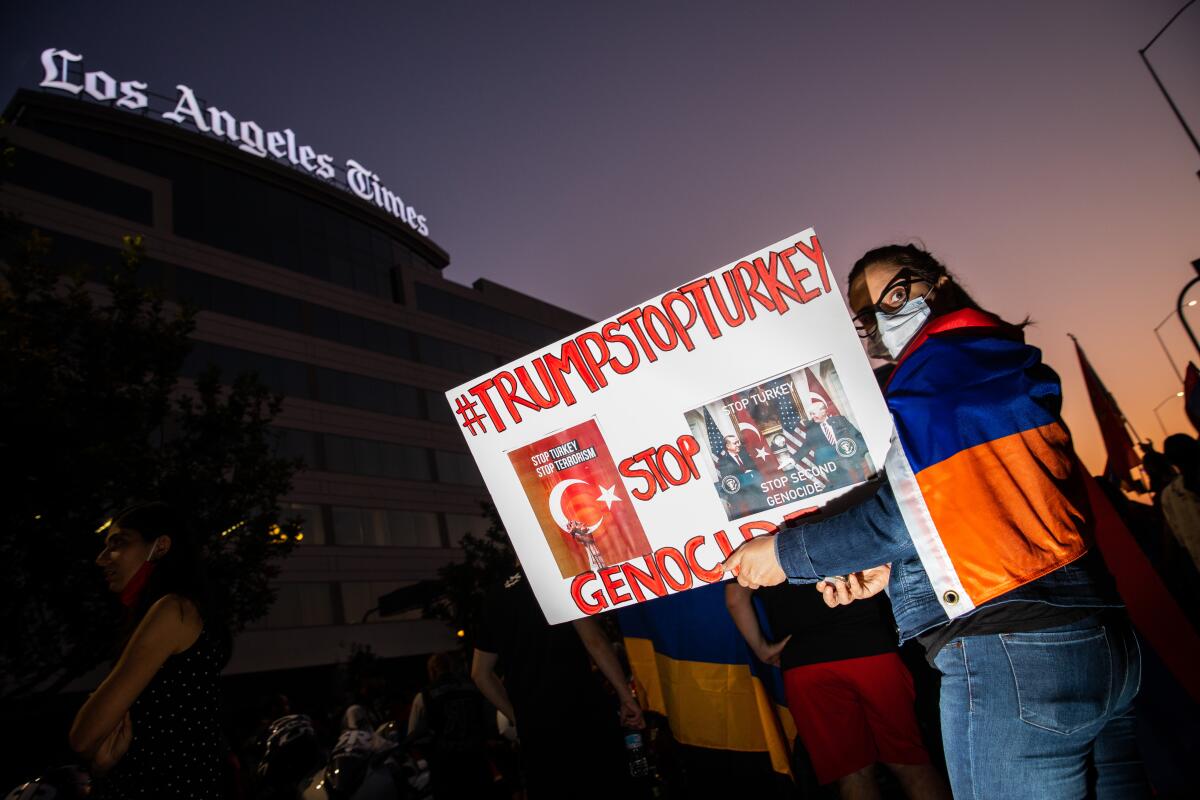
Who makes up Southern California’s Armenian American community?
“In the beginning, the earlier generations were tied to the Armenian genocide, and now you have more current migrants who might have participated in the 1994 war,” Gamaghelyan said.
So these are direct ties to Armenia and Artsakh, not an abstract relationship, Chahinian said.
But there’s also a lot of internal diversity in the Armenian American population in Southern California, she said.
“There are the Armenians who left Armenia in the Soviet area, bringing that experience,” she said. “There are those who left in the years following independence during economic hardship. There are Armenians from Middle Eastern countries like Syria and Lebanon, most of whom left during the Lebanese civil war in the years 1975 to 1990.”
Chahinian is from Beirut, and both her grandparents were refugees and survivors of the genocide.
“There are also Armenians from Iraq and from Iran, who left at the start of the Iranian revolution — and so much more,” she said. “So you have a compilation of historical traumas and displacement. You have war, various oppressive regimes and revolutions.”
Despite the diversity of experiences, she sees everyone coming together now for this common goal: “Everyone is just all hands on deck.”
Chahinian explained that many Armenians see this not as a territorial dispute but as a threat to Armenian identity.
“I’ve been hearing colleagues and friends saying, ‘Where else are we supposed to go?’” she said. “And I think that gets to the heart of why Armenians are on the streets, blocking traffic…. What they’re fighting for is 10% of their historical land. People are talking about genocide and ethnic cleansing, but it’s not being thrown around lightly. It’s this idea that it’s this tiny sliver of place that Armenians can call home, and that’s what’s under existential threat.”
Some Armenian Americans in Southern California have traveled thousands of miles to help in the war effort against Azerbaijan.
What are the protesters’ demands?
The main goal is to get more attention about the situation.
“At the end of the day, countries, people, government, dictators … only get to do as much as the world lets them do,” Ghazarian said. “All of them can be impacted by understanding and information.”
Other calls to action, as outlined by the Armenian National Committee of America, include supporting aid efforts to Nagorno-Karabakh, calling for the U.S. to cut all military aid to Azerbaijan and urging countries around the world to condemn Azerbaijani and Turkish aggression.
Is religion a factor?
International media often frame the dispute as one between a Christian country, Armenia, and a Muslim country, Azerbaijan — and Nagorno-Karabakh as a minority Christian enclave within a majority Muslim country.
Although that’s true, all sides have agreed that this is not about religion, Ghazarian said.
“It’s easy to frame like that,” Gamaghelyan said.
He said religion is not an important factor in the local relationship between the two countries, but he acknowledged that religion is exploited by both sides when it comes to outreach to foreign nations — whether it’s appealing to majority-Christian societies or framing the conflict within the context of Islamophobia.
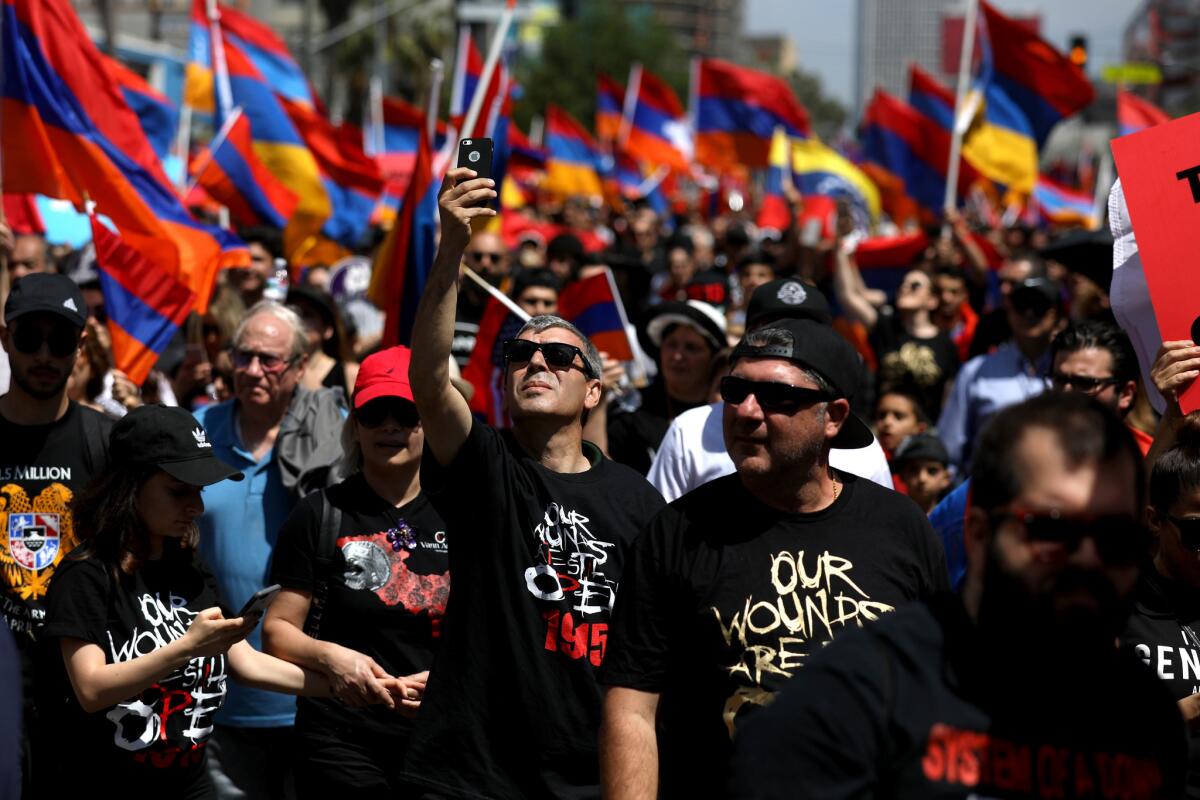
What about misinformation?
Another reason Armenians are protesting is that some take issue with media coverage of the conflict.
On Tuesday, the protest outside The Times’ headquarters in El Segundo was partly driven by anger over a story that quoted Nasimi Aghayev, the consul general of Azerbaijan in Los Angeles, who accused Armenia of promoting white supremacist propaganda.
But Gamaghelyan said another part of the problem is that both countries block certain information.
“Azerbaijan has technically closed off their social media outside of the country,” he said. “And they don’t let independent journalists enter the zone from their side. Armenia also passed a war declaration restricting freedom of speech, banning information other than from their official channels to be spread.”
As a result, much of the information reported is coming from each country’s military.
“Each side reads their own official information, that they’re being attacked by the other side,” he said. “So there’s different information being passed to each community.”
People also get information directly from the region, Chahinian said.
“They have siblings serving on the front lines, families displaced, so the news they’re getting is from daily phone calls, real-time updates, family members who have died,” she said.
Is there an Azerbaijani population in Los Angeles?
Azerbaijan’s population is about triple that of Armenia. Though there is an Azerbaijani community in the Los Angeles area, it’s small compared with the Armenian American community here, Gamaghelyan said.
Ulduz Azar, an officer of the Azerbaijan Cultural Society of Northern California, told The Times that her local community in San Francisco has also been raising money to send to Azerbaijanis who have lost family members or whose homes have been destroyed.
“We’re all very, very worried and tense,” Azar said. “We are trying to do our best to help those who are impacted.”
What has the response been from U.S. officials?
In April, Democratic presidential hopeful Joe Biden vowed to support a resolution acknowledging the Armenian genocide if elected in November, something presidents Trump, Obama and others did not do.
In a Sept. 28 statement, Biden called on the Trump administration to step up diplomatic efforts.
“The eruption of hostilities in Nagorno-Karabakh runs the risk of escalating into a larger regional conflict, which is why third parties in the region must stay out of this conflict and the Minsk Group mediators must immediately seek de-escalation and a return to negotiations,” Biden said.
At the time, Trump told reporters he had just learned about the issue and was looking at the situation “very strongly.”
This month, Nikol Pashinyan, Armenia’s prime minister, said Trump had promised to call him about the intensifying conflict before he became sick with COVID-19.
On Monday, a group of officials, including Los Angeles City Councilman Paul Krekorian and state Assemblyman Adrin Nazarian, gathered at Los Angeles City Hall in solidarity with the Armenian community and called on the Trump administration to intervene diplomatically.
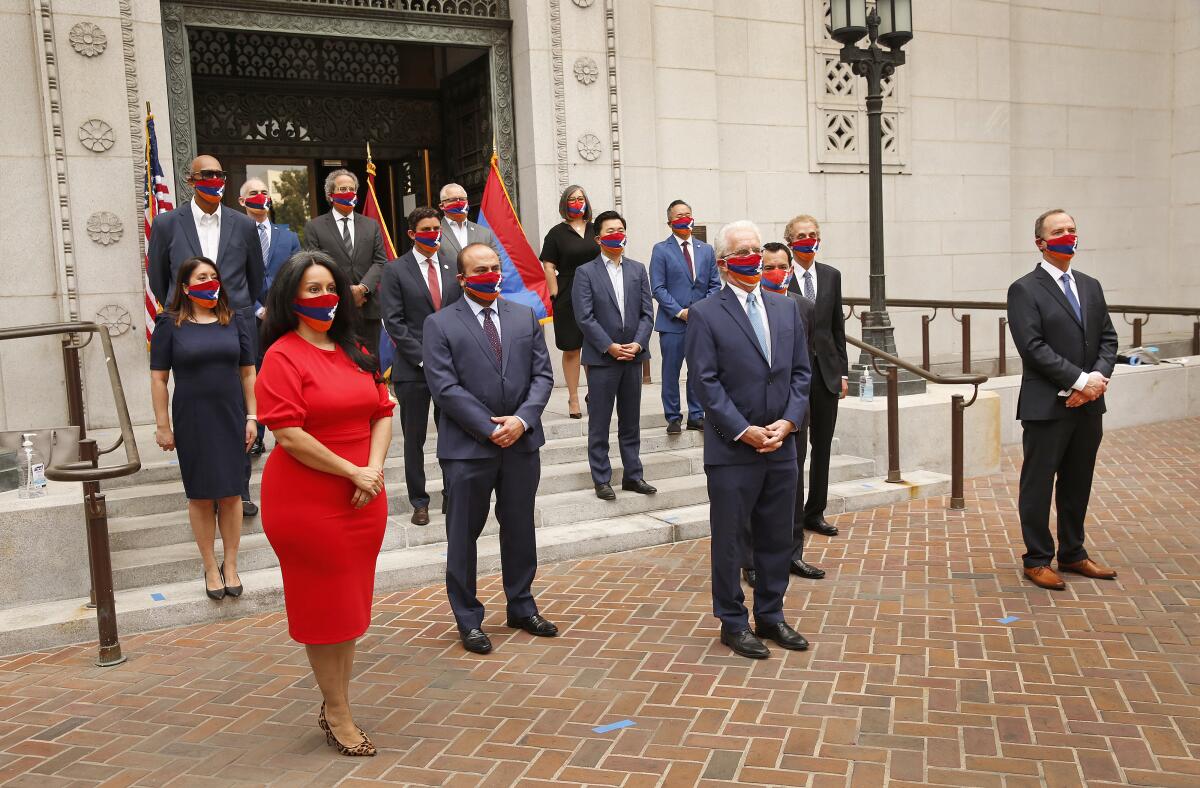
What could happen in the future?
“Sooner or later, most likely after the election, the U.S. may get involved,” Gamaghelyan said. “So there’s a very good chance of it becoming another hot spot of international competitions.”
“At the end of the day, there needs to be a peaceful negotiated solution,” Ghazarian said. “Any other solution won’t work, otherwise it would’ve worked by now…. If military conflict alone did it, we’d be done, but we’re not done.”
More to Read
Sign up for Essential California
The most important California stories and recommendations in your inbox every morning.
You may occasionally receive promotional content from the Los Angeles Times.
